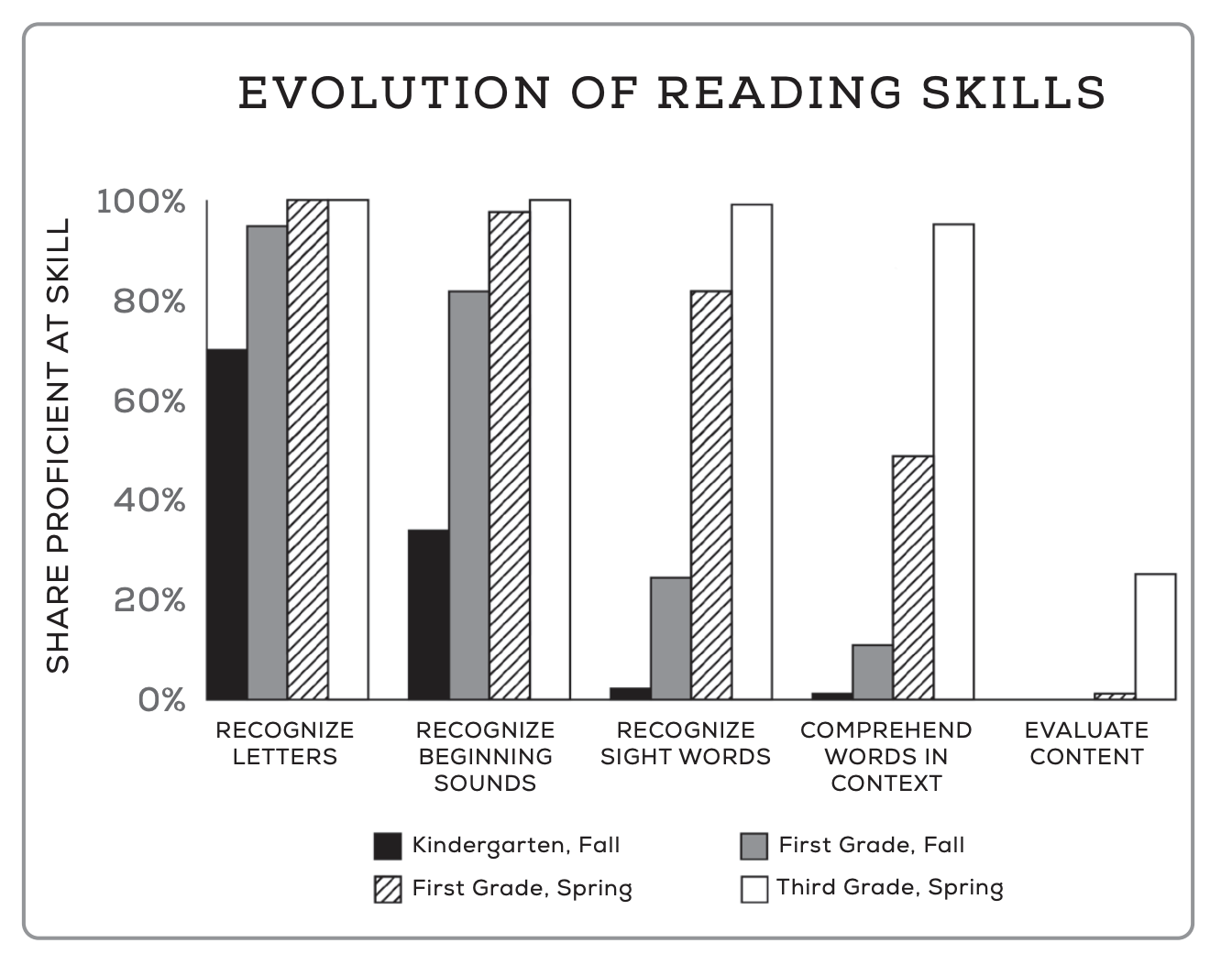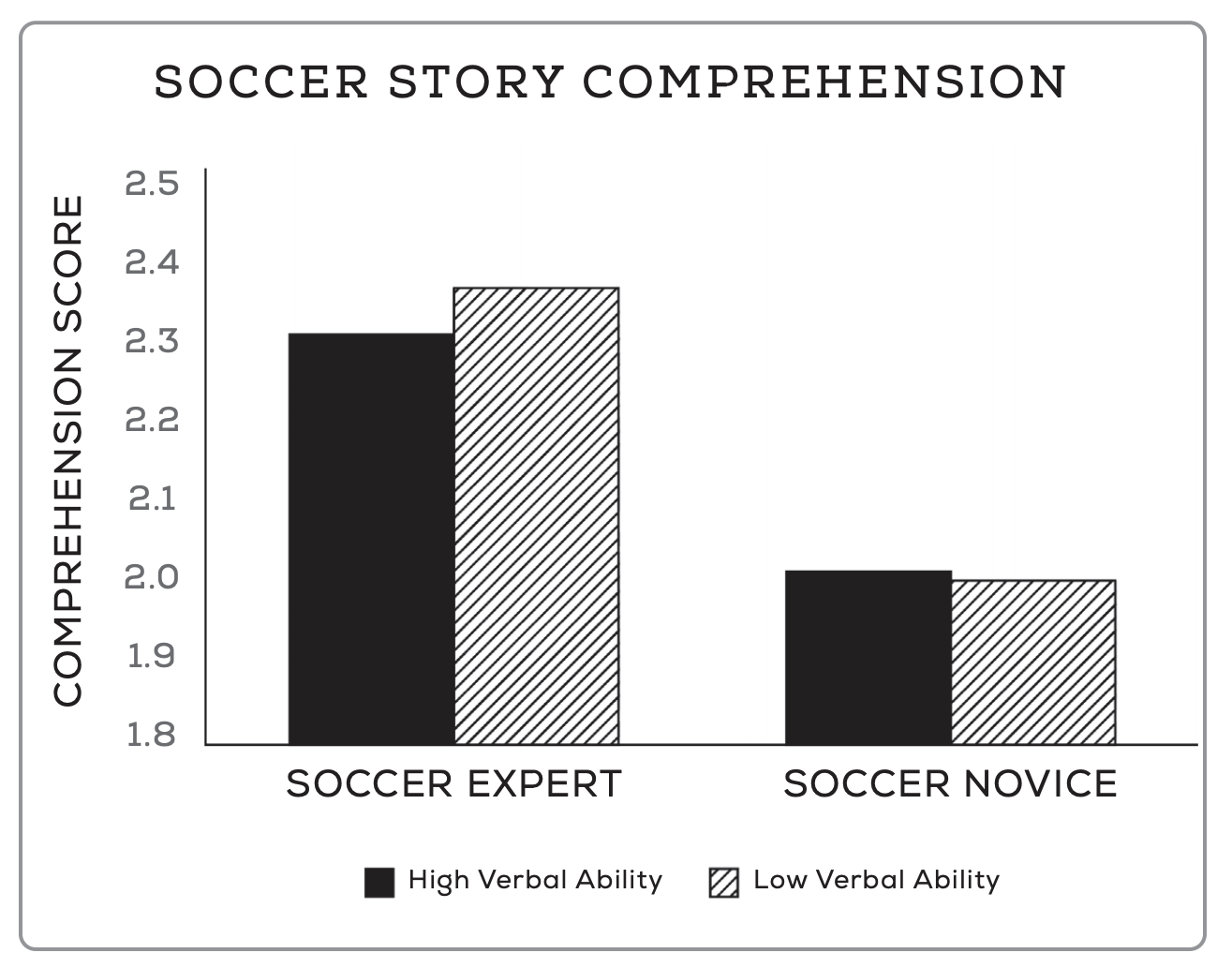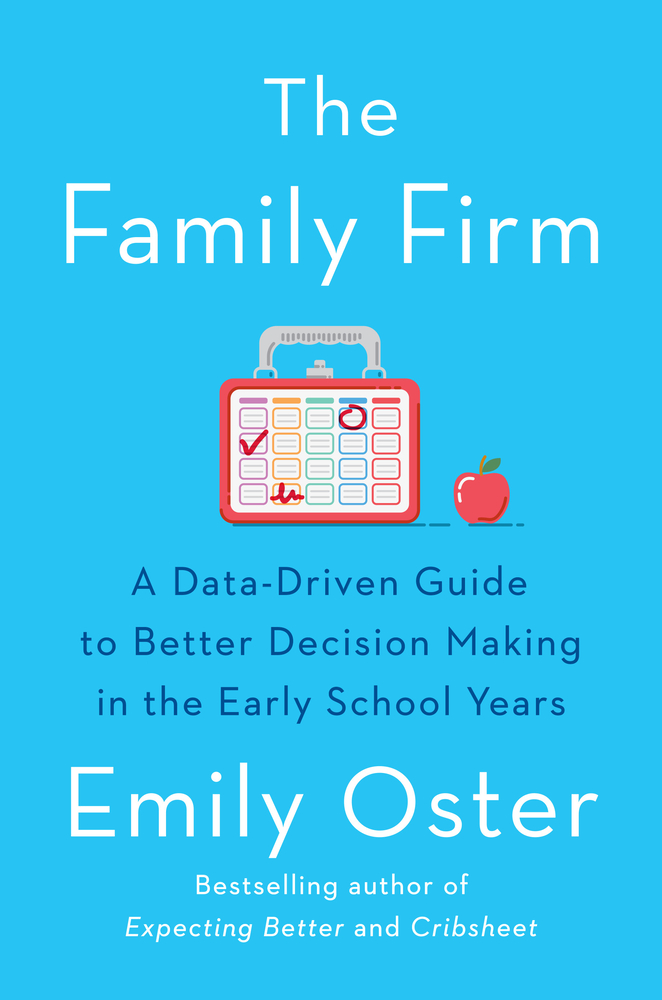
Among my favorite book genres is histories of 19th‑century polar expeditions (spoiler alert: it’s super, super cold and a lot of people die). My husband, Jesse, and I share many interests, but not this one. The last time I read one of these books and tried to tell him what was happening, he retaliated by explaining the details of the book he was reading, which was—I’m totally not making this up—a history of the German Federal Statistical Office.
But for me, a close second to books on polar explorers are books on neuroscience, which is where I think it makes sense to start in understanding the question of how kids learn to read. Because before thinking about how kids learn to read, it is useful to think about how adults (or fluent readers in general) actually read.
Of particular relevance is the question of whether you read by recognizing words or by sounding them out. If you’re a fluent adult reader, you probably think that you read by recognizing words and just knowing what they look like. Basically, you perceive yourself using some kind of pattern recognition—when you see the word read, you recognize it as “read.” You do not think of yourself as sounding it out. And for a word like read, this is likely correct. For short, common words, we seem to read through pattern recognition.
(How do we know this? One piece of evidence is that for short words—say, under eight characters—the length of the word doesn’t influence our reading speed. If we were sounding it out, this wouldn’t be the case. Other evidence comes from brain scans that look at how the brain processes real versus imaginary words.)
But it turns out that although you do not perceive it, you actually also make use of a fair amount of phonics (basically, chunking words and sounding them out) inside your brain when reading. You do it fast! But that doesn’t mean you don’t do it. And it’s the reason we can process words we haven’t seen before, or imaginary words.
For example, here’s a word I made up: delumpification. You can likely read this, in the sense that you could pronounce it. And beyond that, you probably can work out what it would mean (something like, “the process of removing a lump”). But this isn’t because you recognize the word! Implicitly, your brain is sounding it out in pieces it knows: de / lump / ification (perhaps—our exact knowledge about how this type of word gets chunked isn’t perfect).
There is some push for what people call “balanced literacy,” meaning that basic phonics instruction is combined with more interesting story reading.Understanding this process, and in particular understanding the sense in which even fluent readers rely on sounding out to read, has implications for how kids learn to read. Notably, it is key to the great debate over teaching phonics versus “whole language” reading.
Traditionally, reading has been taught through the use of phonics—kids learn the sounds of letters, then how they fit together (the consonant‑vowel‑consonant words), then common exceptions (“if there is an e at the end, a says its own name”; “ou” says “oww,” etc.), then weirder things (the silent k and so on).
If you’re familiar with them, think of the Bob Books. They start with just four letters (a, m, s, and t) and the first book in its entirety is: “Mat, Mat sat, Sam, Sam sat, Mat sat on Sam, Sam sat on Mat, Mat sat, Sam sat.” The next book introduces more letters (c, d), and so on.
Phonics has been used (successfully) for decades, probably hundreds of years. But at some point, some people suggested it might not be the best approach. Beginning in the late 1960s, a movement (credited to, among others, linguist Noam Chomsky) suggested that it might be better to teach reading with a more “whole‑language” approach. In particular, this movement argued for forgetting about phonics and immersing children in language and stories with the expectation that they would, effectively, learn pattern recognition to read words.
To simplify somewhat, there were a couple of arguments in favor of this. One is that phonics is boring. That “Mat” story from the Bob Books? No five‑ or six‑year‑old will find it exciting. It’s a chore. Similarly, drilling on the millions of exceptions in the English language is tedious. Why on earth is the k silent? A whole‑language approach skips right to better stories—not Harry Potter, but at least something that’s not quite so pedantic. So maybe it holds kids’ interest better.
As more time is scheduled for homework and activities and kids get more access to technology, reading may take a back seat.The other point this movement made is that when adults read, they read through pattern recognition, and if that’s where kids are headed anyway, we might as well start there. The whole‑language approach got some traction in the 80s and 90s; at some point, California public schools adopted a version of it, as did Massachusetts. As it turns out, however, ignoring phonics is not an appropriate way to teach reading.
For one thing, as mentioned earlier, adults reading by pattern recognition alone is wrong. Even fluent readers are using a form of sounding out to read many words. So chunking words and putting them back together is a key tool. This suggests that we ignore it at our peril.
But we can also see the failure of this whole‑language approach in experimental data. A team of researchers at Stanford showed this in a clever experiment in which they invented a new script and attempted to teach it to undergraduates. The script had English sound correspondence, but the letters looked different. Some undergraduates were encouraged to learn using a phonics frame (basically, to work out which squiggle corresponded to which sound) and others were encouraged to use a whole‑word approach (memorizing which picture corresponded to which word). The students using the whole‑word approach initially did better, but once more words were added, they were unable to keep up; phonics facilitated the reading of a larger number of words with a smaller number of symbols. A large number of studies show that phonics‑based reading instruction is more successful than whole‑language reading. Some people have even argued that the California adoption of this whole‑language approach was responsible for a precipitous decline in test scores in California in the 80s and 90s, although this is subject to some debate.
In the end, phonics has returned, and this is almost certainly what your child’s school will use. (It’s also probably how you should teach them to read, if you choose to do it yourself.) If you find that your child’s school has adopted a whole‑language approach, you should ask a lot of questions.
There is some push for what people call “balanced literacy,” meaning that basic phonics instruction is combined with more interesting story reading. This adopts some of what is “fun” about the whole‑language approach—you can quickly move beyond the Bob Books—but the main focus stays on phonics as the central learning tool.
So, when will this all happen? When is your kid actually going to learn to read?
If you want to pitch reading as entertainment, you need to be prepared to let them pick what they want.
I talked some in Cribsheet about reading among very young children. You can certainly find products that tell you your baby can learn to read. They can’t! Science has proven it. Please, please do not try to teach your baby to read (it will frustrate and disappoint you, they probably will not like it, and it will not work).
Toddlers and preschoolers also (in most cases) cannot read fluently. Kids of two and three years old will often start doing some pattern recognition—recognizing their name, or the M in the McDonald’s arches, or a particular logo. This is great, and it’s great to encourage it! But it’s not reading. Some very young children do learn to read fluently, but it’s unusual. With an older three‑ or four‑year‑old, you may be able to start doing some early phonics, and certainly a four‑year‑old can understand the idea of letters. This may especially be true if they have an older sibling who is learning to read. (One thing to note here is that there is often a lot of focus on learning the names of the letters, but this is actually far less important for reading than the letter sounds.)
Most kids learn to read—to put letters together into words and read somewhat fluently—sometime between first and third grade. We can see this in data.
The following graph shows the evolution of reading skills based on data from the Early Childhood Longitudinal Study, a study that tracked a cohort of students who were in kindergarten in 1998. Students in this cohort were evaluated on their reading skills in kindergarten, first grade, third grade, fifth grade, and eighth grade. At each time period, they got a score that indicated their proficiency at each reading skill. These skills start at letter recognition and go all the way up to evaluating the students’ comprehension of complex nonfiction texts.
I focus here on the evolution of students’ reading abilities early in their school career—from kindergarten through the end of third grade. When the kids entered kindergarten in the fall, most of them (about 70 percent) could recognize letters, but only a small share (about 30 percent) could recognize beginning sounds of words. Virtually none of them could recognize sight words or comprehend words in context (this last milestone would be close to reading simple texts).
By the start of first grade, letter recognition and beginning‑sound recognition had advanced, but still only a small share of kids could recognize sight words or really read texts. This skill enormously advanced during first grade. By the spring of that year, 80 percent of the cohort could recognize sight words and about half could read in context.
By the end of third grade, virtually the whole cohort was reading fluently, although still only about a quarter of them were comprehending texts at a high level. This skill comes later in the data, toward the end of fifth grade and especially by eighth grade.

Note that this varies a bit across languages. English is harder to read than a language like Spanish or Italian, since the latter have effectively complete letter‑to‑sound correspondence, whereas English has a lot of spelling exceptions. As a result, Spanish and Italian speakers learn to read faster. Languages with characters rather than letters (like some East Asian languages) are much harder—they require more of the whole‑language approach by definition—and take much longer to read fluently.
Based on the data in the previous graph, we see that by the third grade nearly all the children can read somewhat fluently, and a good share are starting to be able to better understand what they read—to move from “learning to read” to “reading to learn.” And then the question becomes: Can you get them to like it?
Much ink has been spilled on the question of how to get your kids to like to read. An Amazon perusal reveals plenty of book‑length takes—Raising Kids Who Love to Read, Resistant to Reading: Tips and Tricks, How to Get Your Screen-Loving Kids to Read for Pleasure, and so on. To a large extent, these books focus on a category of kids they label “reluctant readers”— basically, kids who aren’t really into reading for fun.
Kids can be reluctant readers at any age, but it’s also worth noting that as kids age, they tend to read less for pleasure. It’s not that surprising—as more time is scheduled for homework and activities and kids get more access to technology, reading may take a back seat.
This is perhaps one of the many times in parenting we should step back and remember that our kids are their own people and some things are out of our control.The books dedicated to this issue have two central messages. First, if you want to encourage your kids to read for pleasure, it helps to explicitly make time for this. You may want to say, for example, “Our family is going to take this 45‑minute block on a weekend afternoon to all read together.” Generally, the idea would be to pitch this as “free” reading time—you can read anything you want: catalogs, baby books, a serious novel, whatever. It’s not a punishment, it’s a form of entertainment. Like family movie night, but with books.
There are various obvious times to do this—before bed, free time on weekends, early morning before it’s wake‑up time. My kids do a lot of their reading at breakfast (our family rule is you can read at breakfast and lunch but not dinner, which makes it seem like a treat). As you think about this, though, you do want to go back to the family Big Picture. Devoting the pre‑bedtime period to reading could crowd out other things—other family time, extracurriculars, sleep, family dinner. And again, having your kid love to read may or may not be super important to you. So be deliberate!
The second key (and perhaps blindingly obvious) message of these books is that kids like reading better if they are good at it and if they understand what they are reading. Closely related to this is the observation that understanding the context of what you’re reading is extremely important for absorbing it.
One nice study demonstrating this was published in 1989 in the Journal of Educational Psychology. The authors took a set of elementary schoolers in Germany and tested their comprehension of a story about soccer; the story was provided both in audiobook and written form, so this was really a test of their verbal comprehension abilities, not reading specifically. The authors categorized the children in two ways before the test. First, they used a generic verbal IQ test to classify the kids as high or low aptitude on verbal skills, including general comprehension and vocabulary. Second, they used a multiple‑choice quiz to assess the students’ knowledge about soccer; they classified the students as either experts or novices on the topic of soccer.

What the authors found—see one of their results in the above graph—was that comprehension of the story (measured in a large number of ways) was much better for those kids who were soccer experts, and this effect swamped any effect of general verbal aptitude. Basically, the kids with low verbal ability who knew a lot about soccer got a lot more out of the story than those with high verbal ability who did not know much about soccer.
Contextual understanding is hugely important for reading comprehension. And, by extension, for enjoying reading. If your kid has no interest in polar bears and no knowledge of polar bears, they are probably not going to enjoy reading a dense scientific treatise about polar bears.
And not every kid has the same set of interests. Various studies have shown that when kids are given a chance to choose what they read, it improves their interest in reading. There are a large number of (mostly school‑based) interventions designed to encourage kids to read. The exact methods vary, but they tend to share the feature that they let kids choose the books they want to read and then encourage kids to talk about the books (thus providing more content and engagement).
Flexibility in reading choice is really important. Yes, your kid is likely to have to read certain books for school—that’s inevitable and probably good for them. But if you want to pitch reading as entertainment, to have a “family reading time” or bedtime reading—you need to be prepared to let them pick what they want. You may have loved A Wrinkle in Time as a kid, but you shouldn’t force it down your child’s throat if they’d rather read The Land of Stories.
Some good share of the time, your kid is probably going to pick books that are below their maximum reading level. This is also okay. Entertainment reading time is not for pushing oneself to the maximum. You yourself are probably not going to read James Joyce for recreation.
Finally, this likely calls for some flexibility in book genre. Increasingly people are recognizing the value of graphic novels for engaging both reluctant and happy readers. For a couple of weeks in the fall of 2019, the bestselling book overall in the US was a graphic novel called Guts by the absolutely awesome Raina Telgemeier. Okay, so it has pictures. But it’s still reading. A similar point can be made for intermediate books like the Diary of a Wimpy Kid, Dog Man, and—I hesitate to mention—the Captain Underpants series.
No matter what you do, even with dedicated reading time and book choice, some kids just like reading better than others. This is also true of adults. This is perhaps one of the many times in parenting we should step back and remember that our kids are their own people and some things are out of our control. It is a hard lesson.
_________________________________

From The Family Firm: A Data-Driven Guide to Better Decision Making in the Early School Years by Emily Oster, to be published by Penguin Press, an imprint of Penguin Publishing Group, a division of Penguin Random House, LLC. Copyright © 2021 by Emily Oster.
